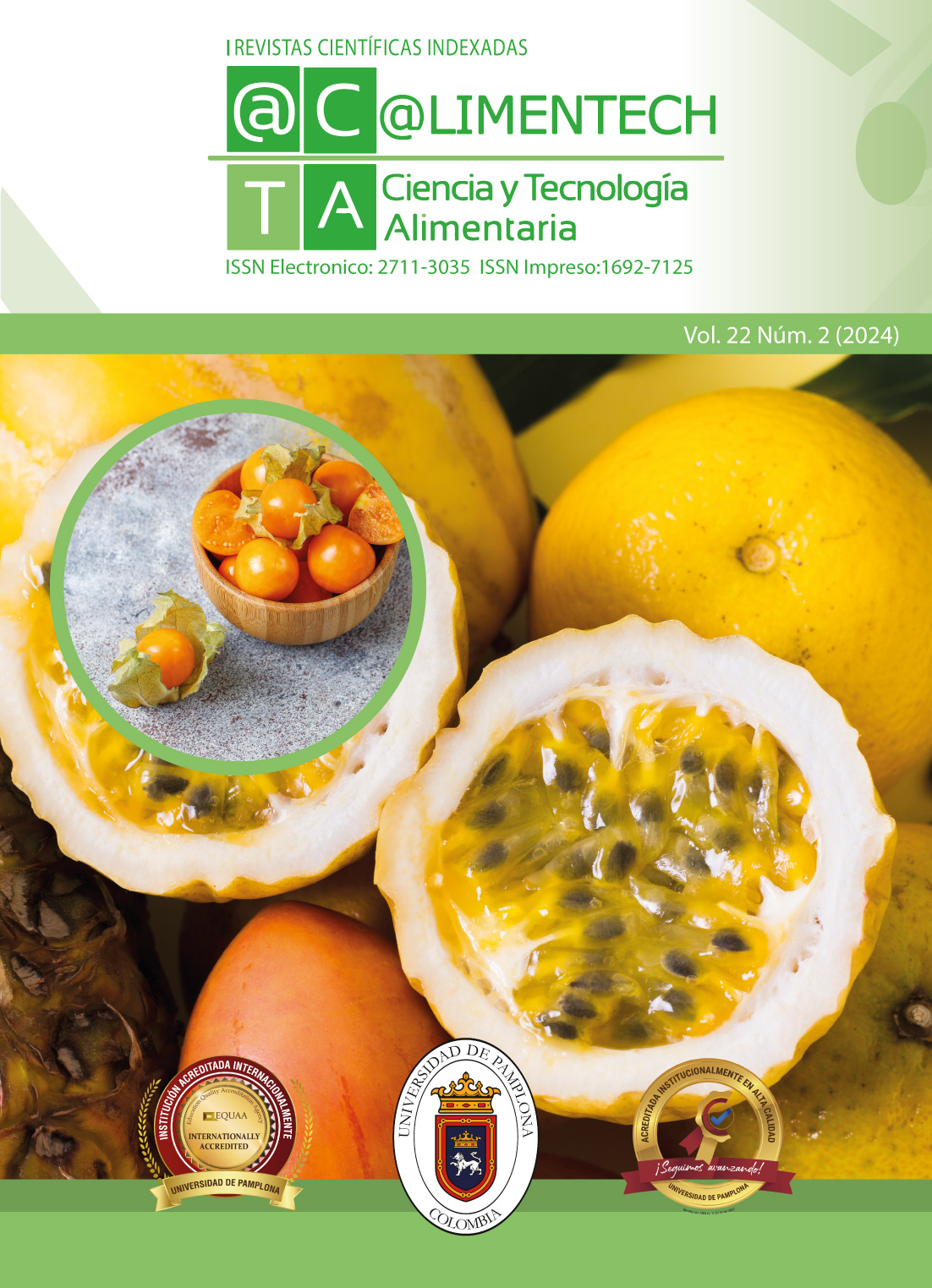Analysis of meteorological and hydrological drought events in the “La Lejía” stream in the municipality of Durania, Norte de Santander.
DOI:
https://doi.org/10.24054/limentech.v22i2.3614Keywords:
meteorology, drought, SPI, SPEI, vulnerability, climate variabilityAbstract
Introduction: Droughts are one of the most concerning environmental issues in recent years, as water resources are essential for human quality of life and the maintenance of ecosystems. The lack of water can generate severe impacts in various areas. In the last decade, the municipality of Durania has faced several drought events caused by high temperatures and low precipitation affecting the entire department of Norte de Santander, as a result of the climate variability phenomenon "El Niño" and global warming. The occurrence of droughts can lead to water rationing for the community, as well as economic losses in sectors such as agriculture and livestock, directly impacting the municipality's economy. Additionally, it can generate negative effects on the flora and fauna of the area. Analyzing how drought phenomena affect agriculture can help farmers better plan their crops to avoid significant losses. Objective: To analyze meteorological and hydrological drought events in the "La Lejía" stream of the municipality of Durania, Norte de Santander. Methodology: First, the physical, shape, relief, and drainage parameters of the watershed were obtained using the digital terrain model from Global Mapper Trial version and QGis free version. Then, climatic indices and anomalies were calculated based on temperature and precipitation variables
using the Google Earth Engine platform, with a 45-year historical series. Additionally, evapotranspiration was obtained using the Thorntwaite equation. Subsequently, meteorological drought indices such as SPI, SPEI, and hydrological indices were obtained using the DrinC program. Results: Historical drought events were identified, occurring in two periods of the year, one from June to September and another from December to February. A comparative analysis was also conducted between the occurrence of these events and the influence of climate variability phenomena such as "El Niño." Conclusions: A bimodal precipitation pattern was analyzed, with periods of lower rainfall identified between June and September and from December to February. Furthermore, the study highlights the years 1980, 1983, 1984, 1996, 2001, 2002, 2014, 2015, and 2016 as the years with the greatest water scarcity. Identifying these years helped to understand the drought events in the watershed and relate them to the "El Niño" phenomenon.
Downloads
References
Alcalde Municipio de Durania. (2003). Esquema de Ordenamiento Territorial (EOT).Oficina de Planeación Municipal. https://repositoriocdim.esap.edu.co/handle/20.500.14471/14240.
Anaya-Andrade, Jonathan Esmith, González-Pedraza, Ana F, Castellano-González, Leónides.(2020). Contaminación con elementos traza en suelos cultivados con hortalizas. Revista@limentech, Ciencia y Tecnología AlimentariaISSN 1692-712 ISSN Impreso 1692-7125./ ISSN Electrónico 2711-3035. Volumen 18 N° 2. Pp: 67-86.https://doi.org/10.24054/limentech.v18i2.3209 DOI: https://doi.org/10.24054/limentech.v18i2.956
Ávila García, P. (2004). Agua y vulnerabilidad socioambiental. Carta Económica Regional, 90, 47-52.
Camino, M. A., Bó, M. J., Cionchi, J. L., López de Armentia, A., Del Río, J. L., & De Marco, S. G. (2018). Estudio morfométrico de las cuencas de drenaje de la vertiente sur del sudeste de la provincia de Buenos Aires(Argentina). Revista Universitaria de Geografía, 27(1), 73-97.
Batista, P., & Dámaso, R. (2016). Algunas consideraciones sobre el comportamiento de la sequía agrícola en la agricultura de Cuba y el uso de imágenes por satélites en su evaluación. Cultivos Tropicales, 37(3), 22-41. https://doi.org/10.13140/RG.2.1.4591.3843
Camino, M. A., Bó, M. J., Cionchi, J. L., López de Armentia, A., Del Río,J. L., & De Marco, S. G. (2018). Estudio morfométrico de las cuencas de drenaje de la vertiente sur del sudeste dela provincia de Buenos Aires (Argentina). Revista Universitaria de Geografía, 27(1), 73-97.
Castillo, M., Ibáñez, L., Valdés, J., Arteaga, R., & Vázquez, M. (2017). Análisis de sequías meteorológicas en la cuenca del río Fuerte, México. Tecnología y Ciencias del Agua., 8(1), 35-52. DOI: https://doi.org/10.24850/j-tyca-2017-01-03
Corponor. (2015). En Norte de Santander se Monitorea el Clima. https://corponor.gov.co/web/index.php/2015/03/26/en-norte-de-santander-se-monitorea-el-clima/
Departamentode Asuntos Económicos y Sociales de las Naciones Unidas. (2014). Decenio Internacional para la Acción «El agua, fuente de vida» 2005-2015. Áreas temáticas: Agua y seguridad alimentaria. https://www.un.org/spanish/waterforlifedecade/food_security.shtml
Gonzáles López, N., Carvajal Escobar, Y., & Loaiza Cerón, W. (2016). Análisis de sequías meteorológicas para la cuencadel río Dagua, Valle del Cauca, Colombia. Revista Tecnura, 20(48), 101-113. http://dx.doi.org/10.14483/udistrital.jour.tecnura.2016.2.a07
González_2020_TG.pdfGuerrero B, Angie.; FlórezF. Albéniz.(2018). Plan HACCP para el aseguramiento de la inocuidad del agua potable tratada y envasada en presentación de 360 ml. Revista @limentech, Ciencia y Tecnología Alimentaria. ISSN 1692-7125. Volumen 16 N° 2. Pp: 65 -85.https://doi.org/10.24054/limentech.v16i1.348
IDEAM. (2024). Condiciones Hidrometeorológicas Actuales.https://ideam.gov.co/sites/default/files/prensa/boletines/2024-07-
Paredes, F., Millano, J. L., & Guevara, E. (2008). Análisis espacial de las sequías meteorológicas en la región de Los Llanos de Venezuela durante el período 1961-1996. Revista de Climatología, 8, 15-27.
Pedroso, D. B. L., Rivera, D. C. F., García, Ms. I. T. G., Rouco, L. D. B., Cancino, Ms. V. C., Sosa, L. M. H., Altamirano, L.R. B., Vázquez, Ms. R. J., Solano, D. O. J., & Pedroso, D. C. G. (2015). El peligro integrado por sequía meteorológica y agrícola. Revista Cubana de Meteorología, 3-17.
Primo-Ordóñez Jorge F, Chávarry-Ysla Patricia Del Rocio.(2020).Análisis de políticas públicas medioambientales en el Perú. Revista @limentech, Ciencia y Tecnología Alimentaria. ISSN 1692-712 ISSN Impreso 1692-7125./ ISSN Electrónico 2711-3035. Volumen 18 N° 2. Pp: 87-103.https://doi.org/10.24054/limentech.v18i2.3212 DOI: https://doi.org/10.24054/limentech.v18i2.995
Serrano Guerrero, S., & Arévalo Sanchez, W. (2020). Plan Departamental De Extensión Agropecuaria.
Unidad Nacional Para la Gestión del Riesgo de Desastres. (2023). Plan Nacional deGestión ante el Fenómeno del Niño. https://portal.gestiondelriesgo.gov.co/Documents/Plan-Nacional-De-Gestion-Ante-El-Fenomeno-El-Nino.pdf
Valiente, Ó. M. (2001). Sequía: Definiciones, tipologías y métodos de cuantificación. Investigaciones Geográficas, 26, Article 26. https://doi.org/10.14198/INGEO2001.26.06 DOI: https://doi.org/10.14198/INGEO2001.26.06
Vega Viviescas, C. (2019). Análisis de sequías meteorológicas e hidrológicas en la Macrocuenca Magdalena –Cauca (McMC) para el período 1980-2010[Universidad Nacional de Colombia]. https://repositorio.unal.edu.co/handle/unal/69784.
Downloads
Published
How to Cite
Issue
Section
License
Copyright (c) 2024 @limentech, Ciencia y Tecnología Alimentaria

This work is licensed under a Creative Commons Attribution-NonCommercial 4.0 International License.








